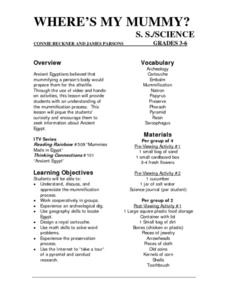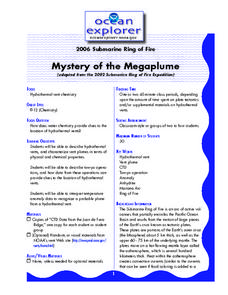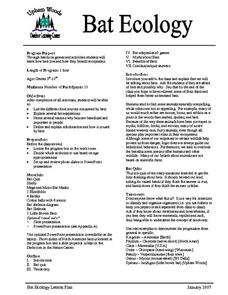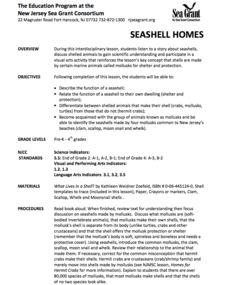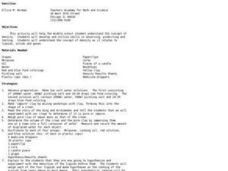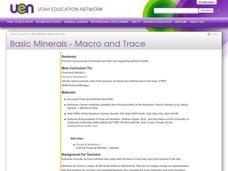Curated OER
Where's My Mummy: Preservation Techniques
To observe preservation techniques firsthand, learners dry a flower in sand and compare cucumber slices soaked in salt water for a week with slices left out to dry in the open air. Video resources (not attached) include one about mummies...
Curated OER
Mystery of the Megaplume
Read through the extensive background information and then lead your geology or physical oceanography class through an investigation of actual temperature anomaly data from the Juan de Fuca ridge. They translate the data onto a plot,...
Curated OER
A Honey of a Hexagon
Students explore how bees make honey and why the hexagon is the best basic pattern for the honeycomb through the use of a video and hands-on activities with honeycombs and geometric shapes.
Curated OER
Discovering Math: Computation
Middle schoolers add, subtract, multiply, and divide rational numbers. They find the square and the cube of numbers. They create a game incorporating computation on rational numbers. Everyone works together to write and evaluate...
Curated OER
Compared to What? Comparing the Density of Different Liquids
Students work in groups to compare the density of different liquids. In this density lesson, students use cooking oil, liquid detergent and water to measure density. Students record their results and check the accuracy of...
Curated OER
Essential Nutrients - Daily Guides
List the recommended dietary guidelines and explain their function and implementation. (The guidelines are listed below) National Standards 14.3.1 Aim for fitness Aim for a healthy weight Be physically active each day
Curated OER
Bat Ecology
Students, through hands on games and activities, discover how bats live and how bats benefit ecosystems. They play a game designed to show them how echolocation works and another to show how mother bats locate their young through their...
Curated OER
Seashell Homes
Pupils listen to a story about seashells. They discuss shelled animals. Learners describe the function of seashell. Pupils relate the function of a seashell to their own dwelling. They differentiate between shelled animals that make...
Curated OER
Living in Extreme Environments: Havens on the Deep Sea Floor
Students identify the characteristics of an extreme environment in the deep ocean and consider what organisms need to survive in these elements. They research sampling and data collection methods in this environment.
Curated OER
Densities
Young scholars explore the concept of density. In this density lesson plan, students determine the density of a crown and a sample of clay. They hypothesize about the densities of 4 liquids they are given including molasses, cooking oil,...
Curated OER
Can You See the Light?
Students investigate the transmission of light energy. In this light energy lesson, students observe bubbles using different colored filters and record their observations. They also look at a light source through various materials and...
Curated OER
With Liberty & Top Soil for All
Learners compare the basic needs of plants to the basic needs of democracy. For this democracy comparison lesson, students complete a worksheet on what happens to a plant that's not nourished. Learners draw a correlation to the basics of...
Curated OER
Edible Color Wheels
Learners create an edible color wheel using cookies and frosting. They mix tints into frosting to simulate the color of the color wheel.
Curated OER
Diversity/Journalism - Book Making
Third graders explore Canadian culture by creating a book. In this community analysis lesson, 3rd graders identify the First Nations people of Canada and discuss the culture, language and diversity. Students create a book discussing...
Curated OER
Basic Minerals - Macro and Trace
Identify minerals, their sources, functions, and deficiencies in the body. National Standard 14.2.1 Discuss macro minerals, electrolytes, and trace minerals Identify the problems associated with calcium and iron
Curated OER
Who Works for Nonprofit Organizations? (6-8)
Students explore career opportunities in the nonprofit sector. In this career exploration lesson, students listen to guest speakers who work for nonprofit organizations explain their jobs. Students also examine the role of nonprofit...
Curated OER
Matter and Molecular Motion
Fourth graders define the states of matter and their properties. They demonstrate the air is matter and observe the effect of molecular motion through these activities.
Curated OER
The Water Cycle
Fifth graders investigate evaporation, condensation, and precipitation. They observe a water cycle kit and record their observations, and examine how water condenses on the outside of a cup. Next, they observe an evaporation...
Curated OER
Making Your Dog Your Best Friend
Students delve into dog training. In this biology lesson plan, students learn that hands, voice and heart is the basis of dog training and through demonstration and take part in a hands-on experience to teach a dog simple commands and to...
Utah Education Network (UEN)
Picnic Field Day
Using laminated paper cookies, get your class exploring the concept of division. Read them One Hundred Hungry Ants, by Elino R.J. Princzes, and have learners model what is happening with toy plastic ants. There are many more fun...
Curated OER
Ways we are Alike/ Ways we are Different
Students complete a chart comparing and contrasting African villages with their own communities. The lesson focuses on the Mbuti and Fulani people. They explore their style of living, their traditions and everyday life in these villages.
Curated OER
Spiders Catch Prey
Students see that spiders catch and eat their prey and are also caught and eaten by their enemies. They sort the pictures into animals that spiders eat, those they do not eat, and those that are spiders.
Curated OER
Watermelon Graphing
Learners discover bar graphs. In this primary math lesson plan, students identify the parts of watermelon seeds and other seeds. Learners learn the proper names and common names which refer to the parts of the seeds as they create a bar...
Curated OER
Phytoplankton and Ocean Color
Fifth graders identify function of phytoplankton in the biospere by conducting experiments and simulations and reading for information. They detect the presence of phytoplankton in bodies of water by examining ocean in satellite images...
